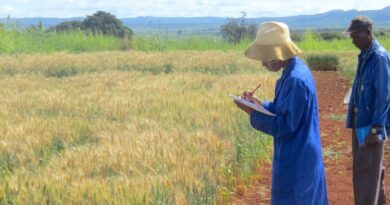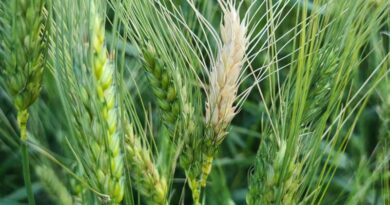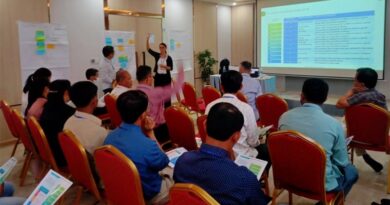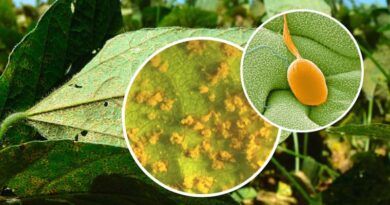Revealing the Rice Blast Switchboard
15 May 2024, California: Scientists at The Sainsbury Laboratory have unveiled a molecular control panel in fungal pathogens that presents potential targets for disease intervention in crops. Their study highlights the extensive network of signaling changes that occur in the fungus Magnaporthe oryzae during its early stages of infection.
Stop-motion video by co-authors Neftaly Cruz Mireles and Lauren Ryder with assistance from their colleagues, Hsuan Pai and Phil Robinson.
The recent publication “The phosphorylation landscape of infection-related development by the rice blast fungus” is the result of exciting research conducted by Neftaly Cruz Mireles during his PhD and a combination of expertise from the Talbot group, TSL Proteomics and TSL Bioinformatics.
“We hope this work not only broadens our understanding of fungal pathogenicity but also paves the way for new strategies to protect crops from these devastating diseases.” says Neftaly, now a postdoctoral scientist at TSL.
Many of the world’s most devastating crop diseases are caused by fungal pathogens, of which rice blast is a formidable example.
The blast fungus, Magnaporthe oryzae, destroys enough rice annually to feed 60 million people. It does so by forming a structure called an appressorium, generating high pressure to penetrate rice leaves.

Formation of infection structures such as appressoria requires major morphogenetic changes and rewiring of signaling events, which depends on protein phosphorylation. This process, which adds or removes phosphate groups from proteins, serves as a dynamic switch for numerous cellular activities.
“By defining the phosphoproteomic landscape of appressorium development in the blast fungus we could determine precisely how regulation of infection-related morphogenesis is controlled at the molecular level.” says Nick Talbot, group leader and Executive Director at The Sainsbury Laboratory.

The research team employed advanced quantitative mass spectrometry to analyze the phosphorylation landscape during the early stages of fungal infection in rice plants and identified a staggering 8,005 phosphorylation sites (phosphosites) on 2,062 fungal proteins. This revealed major re-wiring of the signaling pathways that control protein activity during fungal infection.
To investigate which of these phosphosites might be relevant for plant infection, they compared sites across 41 different fungal species and revealed nearly 1200 key conserved phosphosites.
“It is striking that phosphosite conservation occurs in fungal pathogens sharing particular lifestyles.” Nick comments.
“For example, plant-associated hemibiotrophic fungal pathogens share many MAP kinase-dependent phosphorylation events, and those pathogens that elaborate melanised appressoria share another specific group of phosphosites. This will enable the mechanisms by which these fungi infect their host plants to be investigated and understood, which is a key advance in our ability to study fungal pathogens.”
Head of TSL Proteomics, Frank Menke, adds, “Profiling the phosphorylation landscape during infection related development of the blast fungus on a hydrophobic surface allow us to obtain a deep phosphoproteome that is unprecedented for any filamentous fungus to date. The deep phosphoproteome we acquired allowed us to quantify changes on a large proportion of signalling pathway components necessary for appressorium formation, including the Pmk1 MAP kinase pathway, The Sln1 turgor sensing pathway, selective autophagy and the CpkA pathway.”

The analysis highlighted the central role of the Pathogenicity MAPK pathway (Pmk1), which was previously shown by Miriam Osés-Ruiz, now a TSL alumnus, to be a major regulator of appressorium morphogenesis. By using comparative phosphoproteomics, 32 putative novel components of the Pmk1 cascade were discovered. The authors further showed that phosphoprotein Vts1 is a direct target of Pmk1.
“Vts1 is a novel regulator of appressorium development in the blast fungus that is important for disease and we now know that its phosphorylation is critical for its biological activity”, says Nick.
By demonstrating that phosphorylation of Vts1 by Pmk1 is essential for the development of rice blast disease, a potential target for therapeutic interventions is provided.
Research into plant-microbe interactions is essential for identifying new avenues to develop fungicides and breed crop varieties that are resistant to diseases. This will help create robust and sustainable food systems that are protected against the looming threat of fungal diseases and address the increasing global demand for food.
The authors believe this publication could serve as a cornerstone reference for both researchers and agricultural professionals aiming to curb the impact of fungal pathogens on crops.
Also Read: Geoffrey Hawtin and Cary Fowler to Receive the 2024 World Food Prize for Safeguarding Crop Diversity
(For Latest Agriculture News & Updates, follow Krishak Jagat on Google News)















